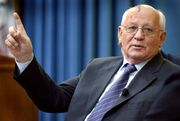
|
This is a featured alternate history!
New Union is a featured timeline, which means it has been identified as one of the best alternate histories produced by the alternate history community. If you see a way this alternate history can be updated or improved without compromising previous work, please say so on this page's talkpage. |
With all the recent tensions caused over Russia's reemergence as a global and regional player, it's rather hard to imagine (especially for recent generations) what the world was once like before the collapse of communism in the late 1980s. Though it may come as a shock to learn that the end of communism didn't necessarily mean the end of the Soviet Union. Prior to its collapse in 1991, Soviet leader Mikhail Gorbachev worked to not only reform the USSR, but to keep it united. This resulted in a "New Union Treaty," which was to be signed on August 20, 1991. The goals of the treaty were to eventually reform the USSR into an equal federation of republics.
The treaty was never ratified, due solely to a coup d'état attempt beginning on August 19 (a day prior to the scheduled signing). Despite the failure of the August Coup, the chaos brought forth from which destroyed the remaining support for a continued union. On December 26, 1991, the Soviet Union ceased to exist, replaced by 15 new nations, and changing the world as we knew it. Now knowing more about the failed August Coup, it's rather silly to think how such a quickly orchestrated and unorganized plot not only failed in its goals but instead accelerated the dissolution of the USSR. Just think what the world might've been like had the coup simply never happened. What might the world be like under such a New Union?
Point of Divergence[]
On the evening of August 18, 1991, four top Soviet officials (Oleg Baklanov, Valeriy Boldin Oleg Shenin, and Valentin Varennikov) boarded a Tupolev Tu-154 in Sverdlovsk. Their destination was the Crimea and ultimately the current residence of Soviet President Mikhail Gorbachev. The goal was to force Gorbachev to relinquish power to his Vice President, Gennady Yanayev, who would in turn remove Gorbachev's reforms. The planned coup was only a few days old at this point, but would never be carried out. Upon arriving in the Crimea, the plane overshot the runway and crashed, killing most of the crew (including the four Soviet officials). Unaware that the men were even coming to see him, Gorbachev rushes to the airport and later announces the men will receive state funerals and that the signing of the "New Union Treaty" would resume as scheduled. When questioned as to why these men were going to the Crimea, Vice President Yanayev told Gorbachev that the men wished to discuss the events for the following day. Upon which, the planned coup had virtually been canceled.

Mikhail Gorbachev.
On August 20, 1991, the Soviet republics of Kazakhstan, Russia, and Uzbekistan signed the "New Union Treaty," paving the way for a new constitution and a the federation of equal republics. Six additional republics would sign the treaty by the end of the year, with the remaining republics eventually gaining independence. The plotters of the failed coup eventually went their own ways. Yanayev resigned as Vice President days after the failed coup. It wouldn't be until the late 2000s that one of the plotters (Boris Pugo) came forward about the failed coup. Despite Gorbachev coming out and saying he had his suspicions, none of the surviving men were prosecuted. The failed coup was planned in order to "save" the Soviet Union. But in reality, the fact that the coup failed was probably the best thing for the Soviet Union (if not the world). Granted, the world is no utopia, but in comparison to what the world has been through (and what could've been), the Soviet people today have a hard time remembering what they've left behind.
Want to contribute?[]
This timeline is open for anybody who shows interest in joining. Before you consider getting started, it is highly recommended that you get acquainted with the editorial guidelines of the timeline.
| |||||||||||||||||
| ||||||||||||||||||||||



